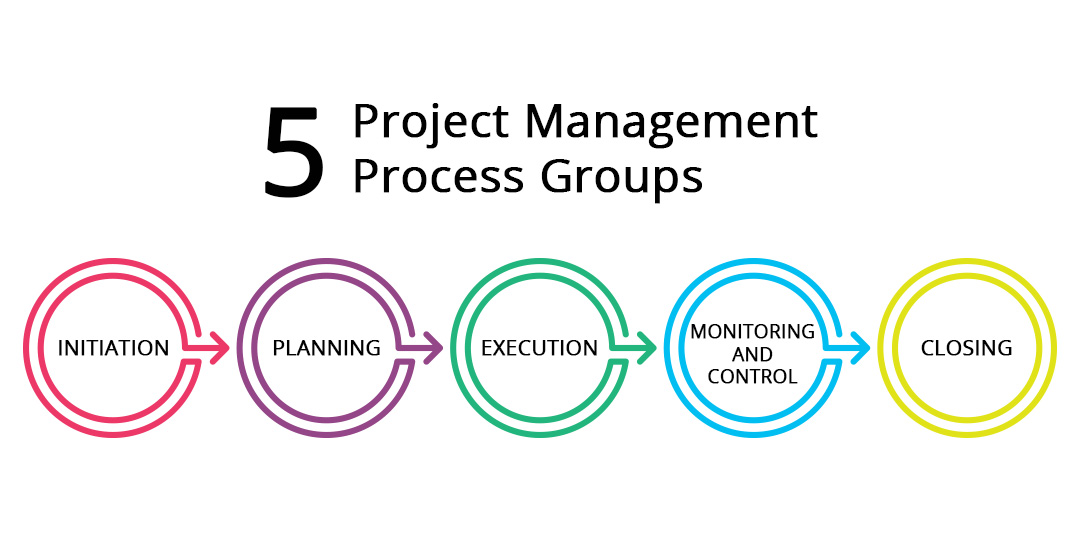Project Management
5 Phases of a Project Management Process

Businesses take on many different projects to fulfill their corporate goals. They run campaigns, roll out events, launch products or services, initiate new procedures internally and externally, and perform many other activities. Processes need to be in place in order to execute and complete projects successfully.
After all, this is project management at work.
Although project management at its core relies on processes for managing and completing projects, project management itself also requires a process. Going through all the stages of the process carefully and correctly can help a business become more efficient in fulfilling the needs and requirements of the project. It can also help them save crucial time, money, and effort, ultimately benefiting the bottom line.
What is a Project Management Process?
In its most basic form, a project management process supports the project lifecycle and can vary depending on the needs of the project and can typically fall into several categories:
- Processes that are followed at specific points in the project life cycle
- Processes that are followed, depending on project needs
- Processes that are followed continuously throughout the project
Each project management process is comprised of the following:
- An input or “entrance criteria” to another process
- The use of an application, tool, system, or technique
- An output or “exit criteria” that leads into another process (such as a deliverable, approval, signed document, and so on)
What Are the 5 Project Management Process Groups?

A project management process consists of five process groups:
- Initiation
- Planning
- Execution
- Monitoring and control
- Closing
Initiation
A project begins with the initiation phase, where a project begins as a conceptualized idea. The initiation stage helps create a high-level project proposal that outlines the idea of the project, how it will work, and how it will meet the business’ requirements. The key decision-makers will then determine if the project is feasible and whether or not it’s worth undertaking.
This process group involves defining the project on a broader level, determining the business need, and creating a project charter.
A project charter or project brief contains the following elements:
- Project goals
- Project scope
- Project constraints and risks
- Project manager and project owner
- Budget
- Estimated timeline
- Other details for the business’s unique needs and structure.
Planning
The planning stage dives deeper into the project details and technicalities that will form the solid foundation for the project. This essentially serves as the entire roadmap of the project.
Here are the most important elements of the planning process group:
- A detailed project schedule - a Gantt Chart can be used to visualize the project and its timeline.
- Identified technical requirements and scope - should define the business need, project benefits, and key milestones.
- Communication plan with communication schedule - proper messaging platforms, procedures, schedules, and stakeholders.
- Risk mitigation - risks are identified and strategies are created to manage, monitor, and control them.
- Goals and deliverables - high-level goals that need to be achieved and accomplished.
In line with laying down the technical requirements of the project, this is also when it’s time to recruit project members and help them get aligned with all aspects of the project — from purpose to goals. With everyone clear on what the project is for and how they should go about their deliverables, delays, errors, and risks can be significantly avoided.
A project plan may be a solid foundation on which the entire project is built. However, project managers and key stakeholders must understand that plans can be prone to change, especially if the changes are necessary to prevent delays and resolve bottlenecks. This is why the planning phase also involves thinking through each and every component and scenario and plan accordingly.
The project plan is the ultimate blueprint that the project will follow all the way to the closing phase. So it’s important to ensure that each and every component is considered and thought through to ensure the smooth execution of the project.
Execution
This phase is where all the actual work is performed. The work activities usually begin with a formal kick-off meeting with all project team members to ensure everyone understands what needs to be done and by when. In some instances, training sessions may be necessary to ensure that the stakeholders can perform their assigned tasks well.
Depending on the nature of your project as well as the structure of your business, the following tasks will be part of the execution phase:
- Assignment and reallocation of resources
- Assignment of tasks and deliverables
- Execution of project plans and task assignments
- Procurement of management
- Setting up of tracing systems
- Conducting status meetings
- Modification of project plans where applicable
While the planning phase produced a step-by-step blueprint of the process, things you didn’t plan for will come up, especially if the risk management efforts are insufficient. The project manager must be able to assist the stakeholders in mitigating the effects of these risks and quickly implement the planned strategies that will help resolve them.
Monitoring & Control
Monitoring and control efforts happen alongside execution. The project manager’s role is to monitor the progress of the project, which includes the following:
- Delegating and overseeing all work activities with project team members
- Managing stakeholder relationships
- Follow the project’s communication plan
- Ensuring the project remains on time and within budget
- Monitor and manage risks
- Address concerns and issues as they arise
- Monitor and track key performance indicators (KPIs)
Project managers certainly have their work cut out for them. This is why project managers use various tools, applications, and systems with monitoring and controlling all aspects of a project.
The monitoring and controlling phase also involves measuring quantitative data in the form of critical success factors and KPIs.
Some common KPIs that are important to measure include:
- Effort and Cost Tracking - accounting for the effort and cost of resources.
- Project Objectives - identifying if the project is meeting the timeline and budget
- Project Performance - monitoring changes in the project because of issues and bottlenecks and how quickly and effectively they are addressed.
- Quality Deliverables - examining the task deliverables and how well they are accomplished.
Quantitative monitoring is crucial to ensure the success of the project and that the team is not deviating from the budget and timeline. It also provides valuable data that are taken into consideration for improving future projects.
Closing
Finally, after deliverables are completed, delivered, or released, the project moves into the closing phase. Once all deliverables have been approved by clients or stakeholders, the project manager then works to close contracts with third-party consultants, suppliers, vendors, and other providers.
The project manager also records and archives all quantitative and qualitative data, project documentation, and key correspondence. This helps the project manager produce the final project report, which will serve as valuable insights for future projects.
It’s also common for a project manager to host a final meeting (also known as a “post-mortem”) for the team to debrief the project, discuss their successes and failures, lessons learned, and recognize and reward the team’s hard work, regardless of the outcome.
Automating Project Management Processes

Project managers are under constant pressure to drive a project to completion, and successfully. Rindle is a reliable project management software that can help plan, organize, and track projects. Rindle is also designed to help automate project tasks and phases, making a project manager’s job easier.
By using one tool to manage it all, project managers set themselves as well as the project team up for success, from beginning to end.